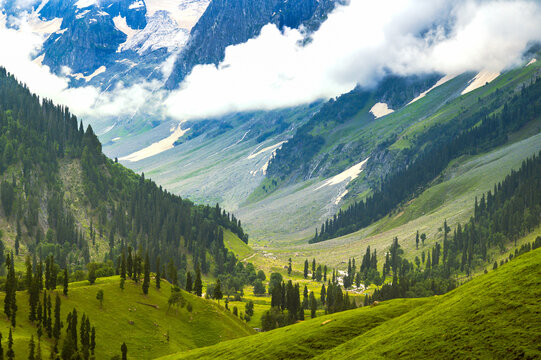A land cradled by the Himalayas, a place of breathtaking beauty and a history as rich and complex as its landscapes. This is Kashmir, a valley that has witnessed the rise and fall of empires, the blending of cultures, and the enduring spirit of its people. Long ago, the Kashmir Valley was believed to be a huge lake called Satisaras, created by the melting snow from the surrounding mountains. According to the Nilamat Purana, a demon named Jalodhbhava lived in this lake and caused destruction in nearby regions. The sage Kashyapa learned of this and sought the help of the gods. Guided by Brahma, the gods assembled on the mountain peaks to confront the demon. Since Jalodhbhava couldn’t be defeated in water, Balabhadra (Vishnu’s brother) used his plough to pierce the mountains and drain the lake. This opening, through which the water escaped, is now the Baramulla gorge, where the river Vitasta (Jhelum) flows. Once the land was dry, Vishnu killed the demon with his divine weapon. And so, the Kashmir Valley was born from the drained lake, with the Vitasta river marking the sacred path of its waters. This description was given by Kalhana in his book Rajtaragini. There are many geological evidences to support the idea of Kalhana.
The Aryans are believed to be among the earliest known settlers in the Kashmir Valley, arriving after the valley had become habitable, possibly after the draining of the mythical lake Satisaras. Their influence can be seen in the early religious texts, rituals, and language patterns of the region. Early Kashmiri shows strong connections to Sanskrit, an Indo-Aryan language. The first major wave of immigration to Kashmir happened during the time of Emperor Ashoka, who brought around 5,000 Buddhist monks to spread Hinayana Buddhism in the region. He built many monasteries and temples, and even donated the valley to the Buddhist Sangha, believing Kashmir was the perfect place for spiritual learning. This move deeply influenced Kashmir’s society. The old caste system, introduced earlier by the Saraswat Brahmins, began to fade among the common people. Scholars in Kashmir studied Buddhism and developed a new form of it known as Mahayana Buddhism. This new form spread to Central Asia, Tibet, China, Japan, and beyond. In return, many students and spiritual seekers from these regions came to Kashmir to learn—and many of them stayed. According to the historian Kalhana, Ashoka founded Srinagar, the capital of Kashmir, and built around 96,000 houses, showing how rich and prosperous the city was at that time.
Kalhana writes that Emperor Asoka worshipped Lord Shiva, known as Bhutesa, at the famous Hamukutaganga shrine in Kashmir. Pleased by Asoka’s devotion and austerities, Shiva blessed him with a son named Jalauka. After Asoka’s death, Jalauka seems to have ruled independently in Kashmir. His spiritual teacher was Saint Avadhuta, who was known for defeating Buddhist scholars in debates. Kalhana tells many stories about Jalauka, the heroic king. One legend says that after reading the Nandipurana, Jalauka learned about the holy Sodara spring (Naran Nag) and began worshipping there regularly. He wanted a similar spring near the Jyeshtarudra temple he was building in Srinagar. One day, he was too busy to visit the spring, but to his amazement, a new spring appeared in Srinagar, with the same water as Sodara in color, taste, and quality.
Jalauka founded many villages, including Varabala (now called Barawal), located on the right bank of the Kankanai River, about two kilometers before it meets the Sindh River. He dedicated 100 women from his royal court to dance daily before the idol at the Jyeshtarudra temple. His wife, Ishanadevi, built temples at the entrances to the Kashmir Valley. After ruling for 60 years, the king and queen retired to Siramochana, where they passed away peacefully.
